
Millions of mobile games are out there battling for engagement, yet only a few titles manage to fight their way to the top. Their secret to success? Mastering the art of LiveOps. That’s why, for this year’s Mobile GameDev Awards, we’ve been celebrating the achievements of the mobile market’s live event champions, looking at the most innovative ways leading studios have kept players invested in their pocket-sized interactive worlds.
Choosing who takes home the trophies is never an easy task, but this year was particularly challenging for our analysts to judge. We saw games igniting player competition and social interaction through innovative LiveOps events, collaborating with beloved IPs to launch all-new gameplay experiences, weaning narrative threads into their content plans, leveraging seasonal themes to keep things fresh, and more.
If you’re struggling with new ways to build on your existing LiveOps strategy, our award winners (which include the likes of Scopely’s Monopoly GO!, Tencent’s PUBG Mobile, and Riot’s League of Legends: Wild Rift) might just have the answers you’re looking for. In this blog, we’ll dive deeper into some of our choices and reflect on the key takeaways.
What makes a great collaboration event?
We’ve written a great deal in the past about the tremendous impact collaboration events can have on player engagement. Theming a live event around an IP that is aligned with the interests of your player base can reengage lapsed players, bring in new players from the IP you collaborate with, and boost monetization through the sale of IP-based skins, characters, and other items. But what makes for a truly great collaboration event?
With around 40% of the top 10% of grossing titles on the iOS US Market incorporating promotional collaboration events into their LiveOps strategies, picking out the best is difficult. All these crossovers come in different shapes and sizes too, spanning everything from fashion brands, automotive, anime, TV, movies, and even other video games.
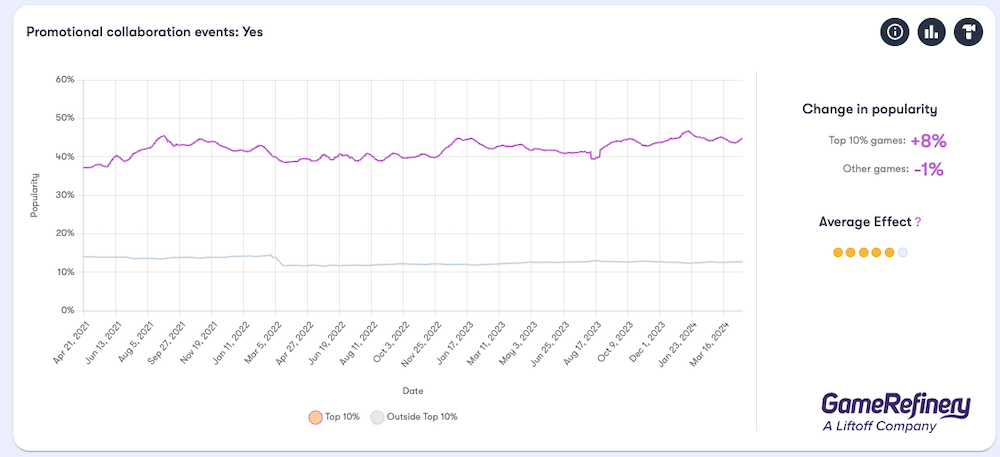
Some of our favorites last year included Free Fire looking Marvelous with a Spider-Man crossover, Roblox turning pink with Barbie, and even Nier: Automata’s android 2B slicing her way into NIKKE: Goddess of Victory. However, two collaboration events in particular really captured our attention.
PUBG Mobile used the Dragon Ball IP to give Battle Royale an Anime Makeover
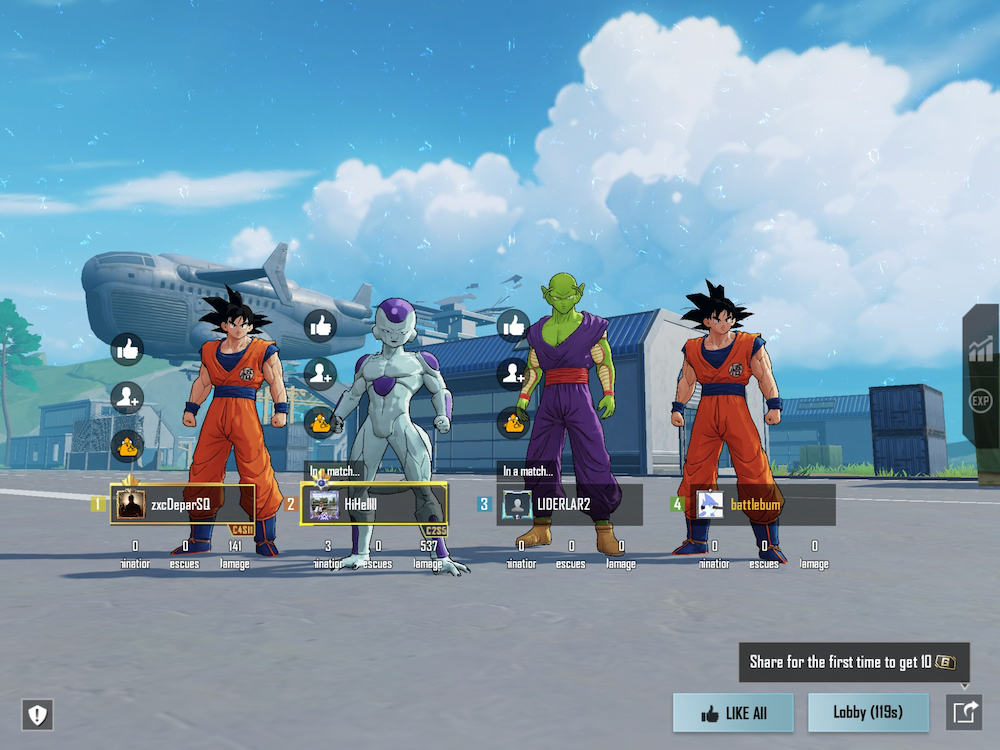
First up was PUBG Mobile x Dragon Ball Super Z, which won our Best Collaboration Event Award for the midcore market. This enormous event ran for almost two months, from July 13 until September 4. It incorporated all the usual features in these events, including a battle pass, various gacha, and new cosmetic items themed around the partner IP. However, it was selected for the award because of its comprehensive Battle Royale: Dragon Ball Super game mode.
The mode gave PUBG’s regular map an anime-themed makeover, with players flying across the battlefield as iconic Dragon Ball characters like Goku, Vegeta, and Frieza – each of which had unique abilities and upgrade trees. Players could also pick up tons of Dragon Ball Super-themed loot scattered around the map, including armor and Tactical Capsules. There were also portals players could use to fast travel, as well as “wind whirls” used to fly up in the air.
While the mode followed the same “last man standing” principles of battle royale, playing it felt like a genuinely authentic Dragon Ball experience. It demonstrated a rich understanding and appreciation for the IP that transformed what it meant to play PUBG.
Stumble Guys uses IP in live events to introduce new gameplay mechanics
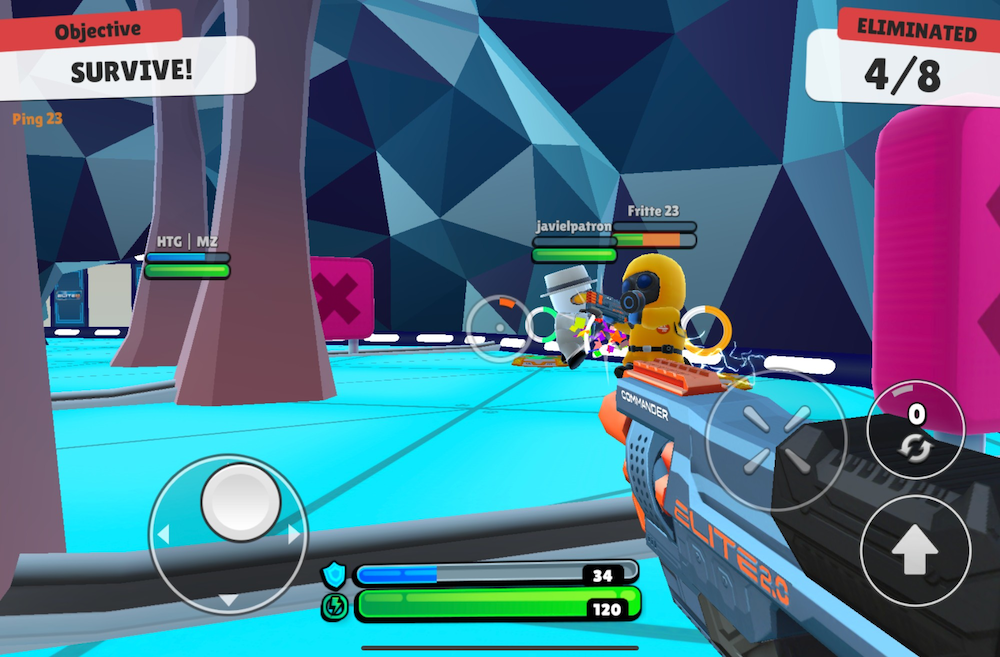
Over on the casual Market, Stumble Guys fumbled home with the other Best Collaboration Event Award. Unlike the rest of the nominees, Stumble Guys stood out for not just one collaboration event but an entire year of them. Throughout 2023 (and now 2024), Stumble Guys has become a collaborative machine, introducing players to everything from MrBeast, Barbie, Monopoly, Spongebob, Nerf, Rabbids, and many more.
Impressively, every collaboration event is just as well executed as the last and acts as the basis for each new season, complete with a battle pass and a wide range of premium cosmetics. Every collaboration introduces a new map themed around the nuances of the IP, many of which have become a permanent addition for players to enjoy, such as:
- The Barbie crossover was based on a neon pink Dreamhouse map where players race to fetch Barbie’s favorite accessories.
- kuFor the Monopoly collab, players sprinted past GO on a map inspired by the classic board game.
- The Nerf collaboration turned Stumble Guys into a first-person shooter, with players wielding their own Nerf blasters in-game.
Stumble Guys understands how to do a collaboration event right and does it right so frequently that it’s hard to pull yourself away because you want to see what it will introduce next. More notably, it’s enabled Stumble Guys to fend off tough competition, with NetEase’s Eggy Party and Tencent’s DreamStar struggling to drum up the same consistent engagement without their own stumbling multiverse.
The power of social and competitive events
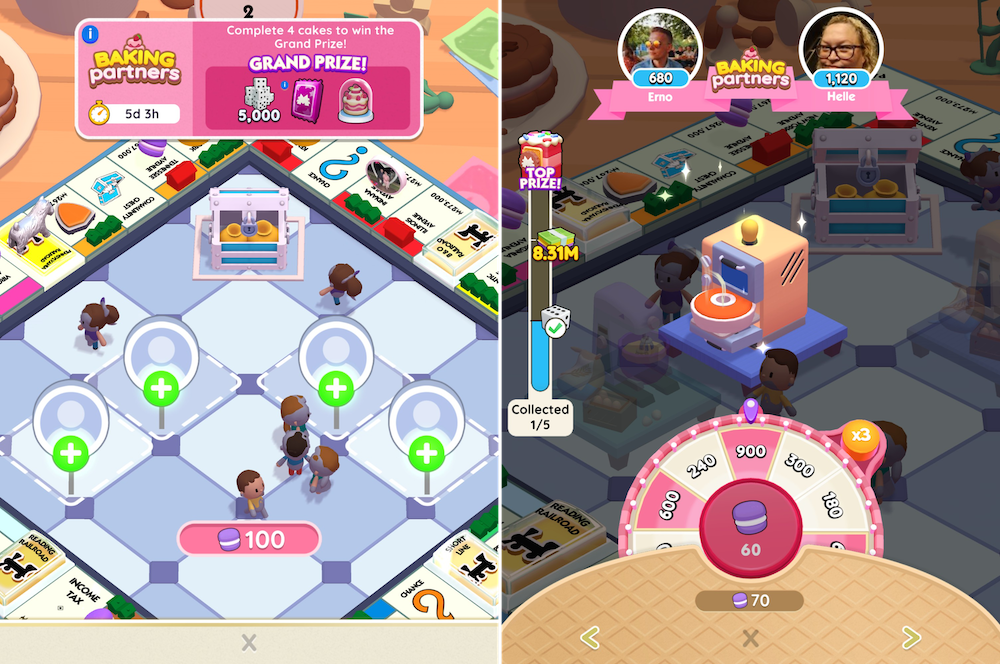
Building a sense of community is one of the best ways to retain players and drive engagement. Mix that with a sense of competition, and you have an irresistible combination. That’s precisely what Monopoly GO! achieved with its Partner Events, which took home the Best Social Event Award for the casual Market.
In these events, a player invites four friends to join them. The catch is that rather than simply becoming a team of five, the main player is partnered up with each friend separately to create four teams of two. Each partner event has a theme (like baking a cake, for example), with each team of two having its own target to reach (done by playing the game and building up event currency). Players receive a special reward if they complete the event with all their partners, encouraging them to make the most of their team-ups.
Social events with a joint goal are usually based around guilds with upwards of 40 players working together. While that’s relatively great performance-wise, because Monopoly GO!’s partner events are much smaller, players typically take these on with their close friends, who are much more likely to encourage them to keep going. This impact is demonstrated in the game’s performance, with the first Partner Event resulting in a surge in daily revenue last July. Similar boosts can be seen each time the Partner Event returns, which is around once a month.
We’re not the only ones who took note of the partner events either. Royal Match, Phase 10, Clockmaker, Project Makeover, and other mobile games have taken inspiration from Monopoly GO! to launch their own iterations of partner events – many of which have been successful.
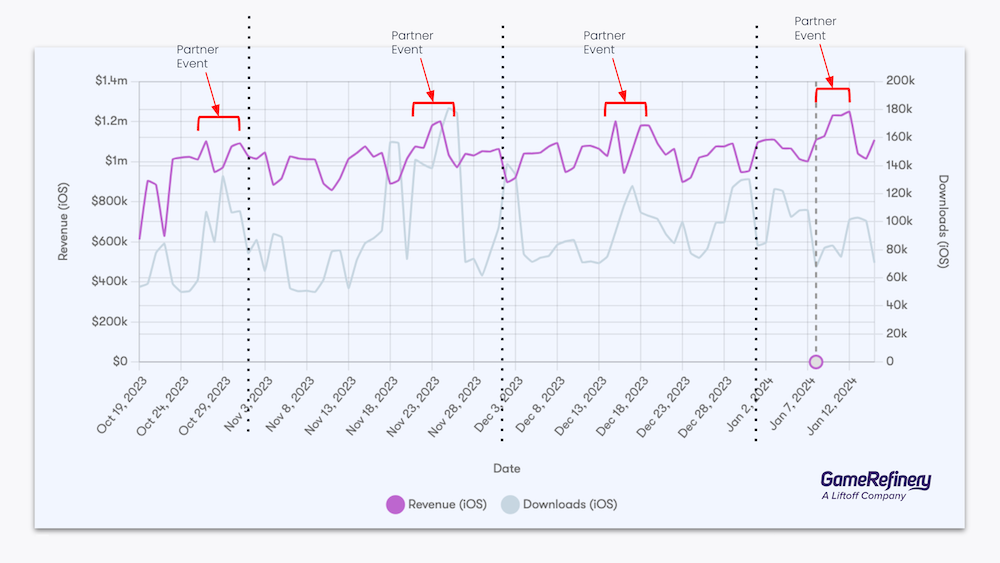
Experiment with live events and identify engaging new gameplay features
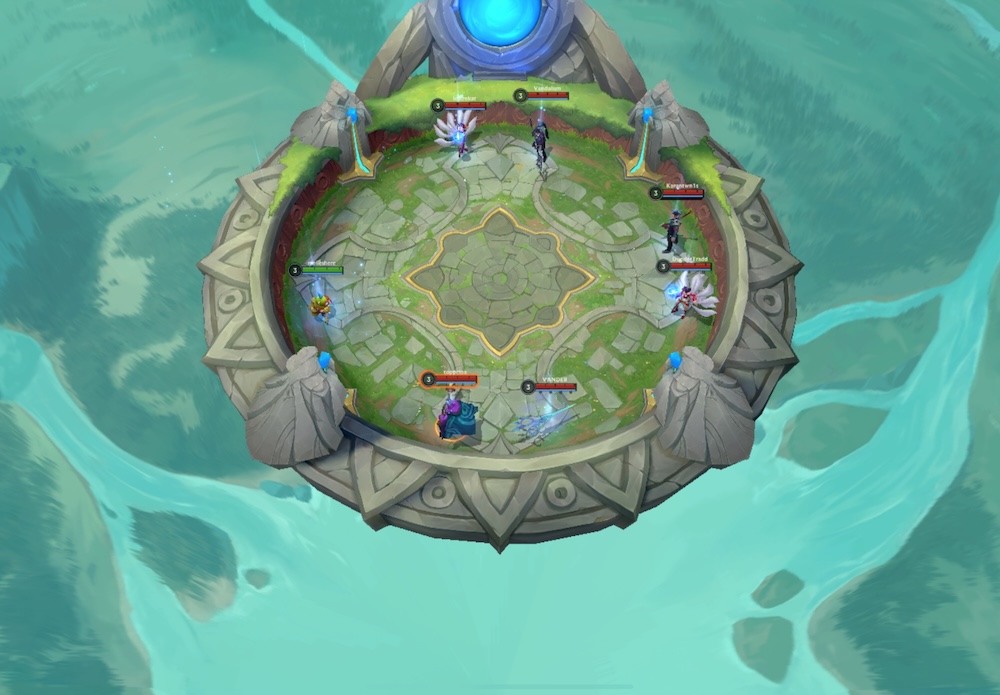
On the midcore side, the winner was League of Legends: Wild Rift’s Arena. In this 2v2v2v2 event, fights are broken down into several 2v2 rounds in small arenas, with each team having a limited number of lives. Players are restricted to using a limited pool of randomized Champions, adding an element of strategy to the gameplay. It’s monetized with an Arena Perk Pass that offers extra benefits, such as a new match-to-match progression layer with Seasonal Augment upgrading.
However, the reason the Arena was selected as the winner was because it’s a standout example of the benefits of LiveOps experimentation. Arena was actually first introduced to League of Legends: Wild Rift in November 2023 as a temporary addition. It proved immensely popular with players, resulting in increases of over 100% in Daily Revenue in the US iOS market in the days following its initial introduction (according to our Live Events Tracker), prompting Riot to bring it back as a full-fledged mode in February this year.
Just like Riot, you can use limited-time events to test new gameplay ideas and features. Once you’ve identified an interesting concept, incorporate this into your content pipeline as a small temporary mode or feature. If it really resonates with players and drums up a lot of excitement, you can build the concept out further and then bring it back as a permanent feature. This way, you’re only heavily investing in features you know are going to be a hit with your players.
Seasonal events that are more than just a reskin
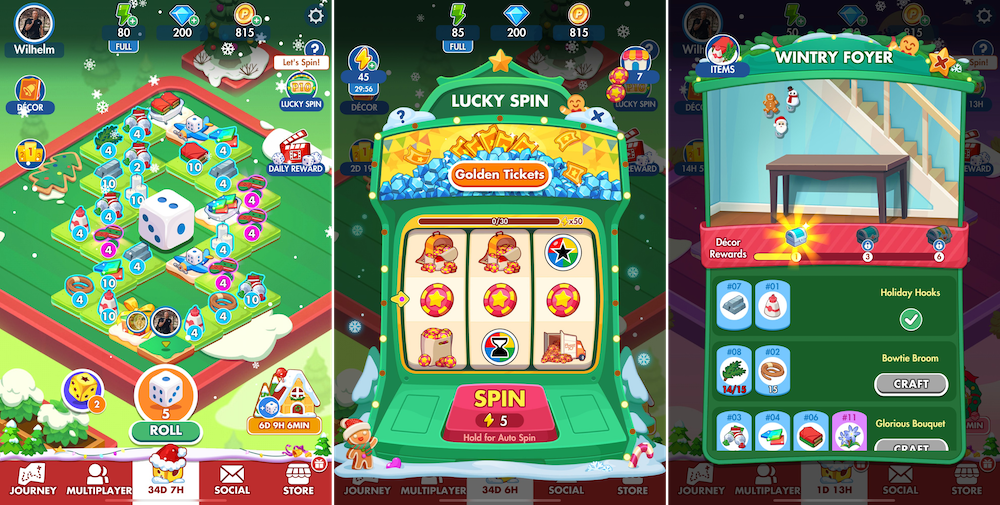
For mobile games, seasonal events like national calendar days and religious holidays present an easy opportunity to introduce exciting new content (think spooky Halloween levels or festive winter cosmetics) that will drive player engagement. However, with over 90% of the top-grossing 100 iOS games using seasonal events to boost revenue, you need to do more than just reskin an existing event to stand out from the crowd.
Phase 10 is one game doing just that, which is why it won our Best Seasonal Event Award for the casual market. Its month-long Christmas event incorporated a wide range of different gameplay features that offered something for everyone.
The main event, Winter Wonder Roll, was centered around a board game where players rolled dice to move their token forward and gain materials to customize holiday rooms – combining a minigame and renovation elements. At the same time, there were also signs of hybridization with casino elements (players could spin a slot machine for bonus rewards), alongside co-op tasks for guilds and a dedicated holiday leaderboard, all of which offered additional rewards.
According to our Live Events Tracker, the game experienced download spikes after the event began on 7 December, particularly in the run-up to the New Year, with increases of around 160% between 30 December and 1 January. In terms of monetization, the event was bolstered through IAP offers that were available throughout its duration. Some of these, such as the Buy 1 Pack & Get 1 Free (Christmas) Bundle, which contained dice event currency required for the event and other goods, boosted daily revenue by as much as 20% while active.
If you’re considering expanding your own Seasonal Events, remember that not all holidays demand the same attention. The mobile game audience comprises billions of players based in different parts of the world with varied interests and beliefs, many of which will only celebrate certain occasions and national calendar dates. For example, Thanksgiving will be of massive importance to many US players, but as it’s not celebrated elsewhere, it won’t interest players in other regions. In other words, identify which holidays will resonate with your specific audience and plan accordingly.
Incorporating Narrative elements into LiveOps
Like a gripping book or TV show, many mobile games use captivating stories and engaging narratives to forge a long-lasting connection with their audience. Once players become invested in the fate of the characters and the game world they inhabit, they’re much more likely to return to see what happens next. By incorporating narrative into a LiveOps strategy, developers can keep players coming back time and again as they unveil each new chapter of the story.
June’s Journey, the casual market winner of our Best Use of Narrative in an Event Award, took a rather bold approach to story-driven live events. With over 70% of the top grossing 20% of games on the US iOS market implementing a battle pass, it can be hard to do something new in this area, and yet here we have a narrative-driven battle pass.
The Travels Pass works like any other battle pass: you progress in the main game and slowly move along the reward track. The difference here is that the game’s story is tied to the battle pass; the only way to see what happens is to progress through all the layers. It’s worth noting that players still receive in-game rewards, which are increased for those who opt into the game’s premium reward layer, but the main driver is the actual narrative (the same for both paid and free players).
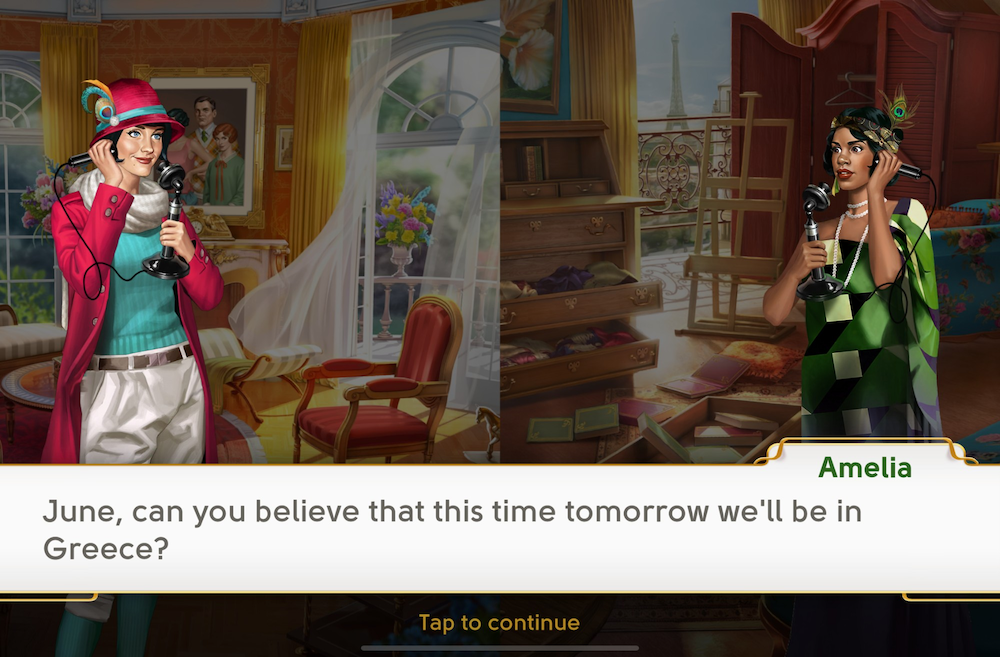
Admittedly, June’s Journey isn’t the first game to attempt a narrative-driven battle pass. The merge game, Gossip Harbor, also launched a successful battle pass with storytelling elements. However, this wasn’t to the same extent as in June’s Journey, but players still received small nuggets of dialogue as they progressed through. Most notably, those players who opted for the premium layer got to see an exclusive part of the story if they progressed far enough.
What can other developers learn from these battle passes? Introducing other elements into live events doesn’t necessarily mean building completely new modes or expansive gameplay mechanics. For example, what if narrative was tied to a daily login or co-op event? With some imagination, you can do a surprising amount with existing features to stand out.
Summarising the biggest LiveOps lessons
Whether it’s boosting downloads, bolstering revenue, or driving overall engagement, each of our 2024 Mobile GameDev Award winners demonstrates the impact an innovative LiveOps strategy can have on a mobile title. If you’re considering sprucing up your own live events based on the work of our trophy holders, here are the key things you need to keep in mind:
- Use IP to create new gameplay experiences: PUBG’s Dragon Ball Z crossover was so successful because it used the crossover to provide an experience that genuinely transformed the game for existing players while also layering on the fan service for newcomers attracted to the IP. To replicate that success with your collaboration events, at the very least, you must have a solid understanding of the franchise you intend to bring into the fold.
- Smaller can be more impactful for social events. By focusing on smaller groups of friends rather than large guilds, like in Monopoly GO!’s Partner Events, players will feel more like part of an actual team and become more invested in the goal.
- When it comes to seasonal events, research which national calendar days and holidays will be most relevant to your player base. For the most important dates, look to Phase 10’s expansive Winter Wonder Roll for inspiration. For others, a simple reskin of a previous event could suffice.
- If you’re looking for more unusual ways to drive engagement, injecting narrative design into existing elements can effectively get players invested in your game’s world. June’s Journey and its story-driven battle pass are good examples of how storytelling can be introduced into preexisting gameplay features.
For more on our Mobile GameDev Award Winners, listen to Episode 54 of the Mobile Games Playbook. Be sure to also check out the complete list of winners and nominees for even more ideas for your own Live Events.
